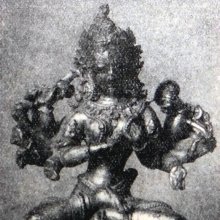Nairrita, Nairṛta: 17 definitions
Introduction:
Nairrita means something in Buddhism, Pali, Hinduism, Sanskrit, Jainism, Prakrit. If you want to know the exact meaning, history, etymology or English translation of this term then check out the descriptions on this page. Add your comment or reference to a book if you want to contribute to this summary article.
The Sanskrit term Nairṛta can be transliterated into English as Nairrta or Nairrita, using the IAST transliteration scheme (?).
Images (photo gallery)
In Hinduism
Purana and Itihasa (epic history)
Source: archive.org: Puranic EncyclopediaNairṛta (नैरृत).—An urban region in ancient India. (Bhīṣma Parva, Chapter 9, Verse 51).
Source: Cologne Digital Sanskrit Dictionaries: The Purana Index1a) Nairṛta (नैरृत).—A Rākṣasa Gaṇa from Nirṛti; the followers of Kubera; hence Devarākṣasas.*
- * Vāyu-purāṇa 69. 173.
1b) One of the four Rākṣasa clans after Nairṛta, moving about during nights: followers of Trayambaka: Devarākṣasas, heroic and valourous, with their leader Vīrūpākṣa: Alakādhipa was their king;1 sons of Revatī and Pūtanā: overlord Skanda: gave trouble to babies.2
- 1) Bhāgavata-purāṇa XII. 11. 48; Brahmāṇḍa-purāṇa III. 7. 141-4, 163; 8. 62.
- 2) Ib. III. 7. 439; Vāyu-purāṇa 84. 14.
Nairṛta (नैरृत) is a name mentioned in the Mahābhārata (cf. I.60.53) and represents one of the many proper names used for people and places. Note: The Mahābhārata (mentioning Nairṛta) is a Sanskrit epic poem consisting of 100,000 ślokas (metrical verses) and is over 2000 years old.

The Purana (पुराण, purāṇas) refers to Sanskrit literature preserving ancient India’s vast cultural history, including historical legends, religious ceremonies, various arts and sciences. The eighteen mahapuranas total over 400,000 shlokas (metrical couplets) and date to at least several centuries BCE.
Shaivism (Shaiva philosophy)
Source: Shodhganga: Iconographical representations of ŚivaNairṛta (नैरृत) or Nairṛtāgama refers to one of upāgamas (supplementary scriptures) of the Kiraṇāgama which is one of the twenty-eight Siddhāntāgama: a classification of the Śaiva division of Śaivāgamas. The Śaivāgamas represent the wisdom that has come down from lord Śiva, received by Pārvatī and accepted by Viṣṇu. The purpose of revealing upāgamas (e.g., Nairṛta Āgama) is to explain more elaborately than that of mūlāgamas (e.g., Kiraṇa-āgama) and to include any new idea if not dealt in mūlāgamas.

Shaiva (शैव, śaiva) or Shaivism (śaivism) represents a tradition of Hinduism worshiping Shiva as the supreme being. Closely related to Shaktism, Shaiva literature includes a range of scriptures, including Tantras, while the root of this tradition may be traced back to the ancient Vedas.
Jyotisha (astronomy and astrology)
Source: Google Books: Studies in the History of the Exact Sciences (Astronomy)Nairṛta (नैरृत) or Nairṛtadiś refers to the “south-western direction”, according to Kāśīnātha Upādhye’s Dharmasindhu, a commentary on the Rāma Daivajña’s Muhūrtacintāmaṇi (an astrological work).—Accordingly, “[...] The water clock [i.e., ghaṭīyantra], thus calibrated, should be placed in a copper basin or clay basin, full of water, when half of the Sun’s orb has risen or set. There this sacred formula is recited. ‘You have been created long time ago by Brahmā as the foremost among the [time measuring] instruments. For the sake of the state of [their] becoming a married couple you be the means of measuring time’. With this sacred formula, preceded by the worship of Gaṇeśa and Varuṇa, the bowl should be placed [on the water in the basin]. If the bowl thus placed moves to the south-east, south, south-west, or north-west [i.e., nairṛta—āgneyayāmyanairṛtavāyavyādidiggatā] of the basin, it is not auspicious. If it stays in the middle, or moves to other directions, it is auspicious. Likewise, if it fills [and sinks] in the five directions starting from the southeast, it is not auspicious. Thus the discussion of the water clock. [...]”.

Jyotisha (ज्योतिष, jyotiṣa or jyotish) refers to ‘astronomy’ or “Vedic astrology” and represents the fifth of the six Vedangas (additional sciences to be studied along with the Vedas). Jyotisha concerns itself with the study and prediction of the movements of celestial bodies, in order to calculate the auspicious time for rituals and ceremonies.
In Buddhism
General definition (in Buddhism)
Source: Wisdom Library: Dharma-samgrahaNairṛta (नैरृत) refers to the seventh of the “eight world protectors” (aṣṭalokapāla) as defined in the Dharma-saṃgraha (section 8). The Dharma-samgraha (Dharmasangraha) is an extensive glossary of Buddhist technical terms in Sanskrit (e.g., aṣṭalokapāla and Nairṛta). The work is attributed to Nagarguna who lived around the 2nd century A.D.
Nairṛta is, besides one of the “eight world protectors” (aṣṭalokapāla), one of the “ten world protectors” (daśalokapāla) and one of the “fourteen world protectors” (caturdaśalokapāla).
In Jainism
General definition (in Jainism)
Source: academia.edu: Tessitori Collection INairṛta (नैरृत) or Nairṛtakūṇi refers to one of the corners (kūṇi) of the samavasaraṇa (sacred space), according to the Golerā temple (Kumalgadh, Udaipur State), which has labels following the same lines as the Samavasaraṇastotra and the Dvādaśaparṣad, both texts dealing with the directions or the ‘corners’ (kūṇi) where the groups of beings (Parṣad) attending the samavasaraṇa sacred space have to sit or stand. The Golerā temple specifies how many figures of each category have to be depicted, e.g., the nairṛta-kūṇi:—4 parṣada Jyotiṣinīdevī, 5 parṣada Bhavanapatidevīnāṃ 4 rūpa, 6 parṣada Vyantaranīdevīnāṃ 4 rūpa.

Jainism is an Indian religion of Dharma whose doctrine revolves around harmlessness (ahimsa) towards every living being. The two major branches (Digambara and Svetambara) of Jainism stimulate self-control (or, shramana, ‘self-reliance’) and spiritual development through a path of peace for the soul to progess to the ultimate goal.
Languages of India and abroad
Sanskrit dictionary
Source: DDSA: The practical Sanskrit-English dictionaryNairṛta (नैरृत).—
1) A demon; भयमप्रलयोद्वेगादाचरव्युर्नैर्ऋतोदधेः (bhayamapralayodvegādācaravyurnairṛtodadheḥ) R. 1.34;11.21;12.43;14.4;15.2.
2) The regent of the south-western direction; निर्घृणं नैर्ऋतादुच्चैर्बलिनं मारुतादपि (nirghṛṇaṃ nairṛtāduccairbalinaṃ mārutādapi) Śiva B.29.22.
-tam The lunar mansion called Mūla.
Derivable forms: nairṛtaḥ (नैरृतः).
Source: Cologne Digital Sanskrit Dictionaries: Edgerton Buddhist Hybrid Sanskrit DictionaryNairṛta (नैरृत).—or °ti (?), m. (Sanskrit Lex. id.), name of the guardian (lokapāla) of the southwest; compare Sanskrit °tī (diś): °taḥ Dharmasaṃgraha 8; °tiḥ Mahāvyutpatti 3156 (read °taḥ? Mironov, however, °tiḥ, printed Naiṛtiḥ).
Source: Cologne Digital Sanskrit Dictionaries: Shabda-Sagara Sanskrit-English DictionaryNairṛta (नैरृत).—m.
(-taḥ) 1. A demon, a fiend. 2. The ruler of the south-west quarter. f. (-tī) 1. The south-west quarter. 2. An epithet of Durga. E. niṛti said to be a proper name, and aṇ aff.
Source: Cologne Digital Sanskrit Dictionaries: Benfey Sanskrit-English DictionaryNairṛta (नैरृत).—i. e. nirṛti + a, I. adj., f. tī. 1. Southwestern, [Mānavadharmaśāstra] 11, 104. Ii. m. 1. A son of Nirṛti, i. e. a Rāk- ṣasa or demon, [Raghuvaṃśa, (ed. Stenzler.)] 12, 43. 2. pl. The name of a people. Iii. adj. Belonging to the Rākṣasas or demons, Mahābhārata 12, 6132. Iv. f. tī, A name of Durgā, [Devīmāhātmya, (ed. Poley.)] 5, 9.
Source: Cologne Digital Sanskrit Dictionaries: Cappeller Sanskrit-English DictionaryNairṛta (नैरृत).—[feminine] ī belonging or consecrated to Nirṛti (also nairṛtya); [masculine] a child of [Name], demon, Rakṣas; [neuter] [Epithet] of a lunar mansion.
Source: Cologne Digital Sanskrit Dictionaries: Monier-Williams Sanskrit-English Dictionary1) Nairṛta (नैरृत):—[=nair-ṛta] [from nair > naiḥ] mf(ī)n. belonging or consecrated to Nirṛti (q.v.), [Atharva-veda; Śatapatha-brāhmaṇa] etc.
2) [v.s. ...] south-western, [Manu-smṛti; Mahābhārata; Suśruta] etc.
3) [v.s. ...] belonging to the Rākṣasas, [Mahābhārata] (See m.)
4) [v.s. ...] relating to the lunar mansion Nairṛta (Mūla), [Catalogue(s)]
5) [v.s. ...] m. a child of Nirṛti, a Rākṣasa or demon, [Mahābhārata; Rāmāyaṇa] etc. (-kanyā f. a Rākṣasa girl, [Rāmāyaṇa]; -rāja m. the R°-king, [ib.])
6) [v.s. ...] m. Name of one of the Loka-pālas (the ruler of the south-west quarter, [cf. Lexicographers, esp. such as amarasiṃha, halāyudha, hemacandra, etc.]; cf. [Dharmasaṃgraha 8])
7) [v.s. ...] of a Rudra, [Harivaṃśa] ([Calcutta edition] nir-ṛti)
8) [v.s. ...] [plural] Name of a people, [Mahābhārata]
9) [=nair-ṛta] [from nair > naiḥ] n. the lunar mansion Mūla, [Varāha-mihira]
Source: Cologne Digital Sanskrit Dictionaries: Yates Sanskrit-English DictionaryNairṛta (नैरृत):—(taḥ) 1. m. A demon; ruler of the S. W. quarter. f. (tī) The south-west quarter.
[Sanskrit to German]
Sanskrit, also spelled संस्कृतम् (saṃskṛtam), is an ancient language of India commonly seen as the grandmother of the Indo-European language family (even English!). Closely allied with Prakrit and Pali, Sanskrit is more exhaustive in both grammar and terms and has the most extensive collection of literature in the world, greatly surpassing its sister-languages Greek and Latin.
Kannada-English dictionary
Source: Alar: Kannada-English corpusNairṛta (ನೈರ್ಋತ):—[adjective] of, belonging to, being in, coming from or going towards the south-eastern direction.
--- OR ---
Nairṛta (ನೈರ್ಋತ):—[noun] = ನೈರ್ಋತಿ - [nairriti -] 2.
Kannada is a Dravidian language (as opposed to the Indo-European language family) mainly spoken in the southwestern region of India.
See also (Relevant definitions)
Starts with: Nairritadish, Nairritakanya, Nairritakuni, Nairritalakshanavicara, Nairritaraja, Nairritatirtha.
Ends with: Aindranairrita.
Full-text (+15): Nairriti, Nairritakanya, Nairritaraja, Nirrita, Manimandapa, Nairuta, Devarakshasa, Kakabali, Nirutar, Nairutam, Nairita, Virupaka, Herukavajra, Niladanda, Vajrakala, Vikaca, Dhvajoshnisha, Ashtalokapala, Dashalokapala, Caturdashalokapala.
Relevant text
Search found 20 books and stories containing Nairrita, Nair-rita, Nair-ṛta, Nair-rta, Nairṛta, Nairrta; (plurals include: Nairritas, ritas, ṛtas, rtas, Nairṛtas, Nairrtas). You can also click to the full overview containing English textual excerpts. Below are direct links for the most relevant articles:
Rig Veda (translation and commentary) (by H. H. Wilson)
Ramayana of Valmiki (by Hari Prasad Shastri)
Chapter 60 - The Titans rouse Kumbhakarna < [Book 6 - Yuddha-kanda]
Chapter 15 - Bibishana reproaches Indrajita for his boasting < [Book 6 - Yuddha-kanda]
Chapter 69 - Narantaka is slain by Angada < [Book 6 - Yuddha-kanda]
Jain Remains of Ancient Bengal (by Shubha Majumder)
Tīrthaṅkara Pārśvanātha with Planetary deities and Dikpālas type < [Chapter 6 - Iconographic Study of Jaina Sculptural Remains]
Ṛṣabhanātha sculptures with miniature Tīrthaṅkaras and Dikpālas < [Chapter 6 - Iconographic Study of Jaina Sculptural Remains]
The Brahmanda Purana (by G.V. Tagare)
Chapter 59 - The Birth of Vaivasvata < [Section 3 - Upodghāta-pāda]
Chapter 7 - Different dynasties enumerated < [Section 3 - Upodghāta-pāda]
Chapter 8 - The race of the sages: Atri and Vasiṣṭha < [Section 3 - Upodghāta-pāda]
List of Mahabharata people and places (by Laxman Burdak)
The Devi Bhagavata Purana (by Swami Vijñanananda)



